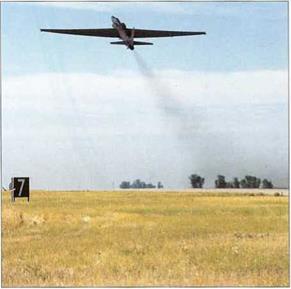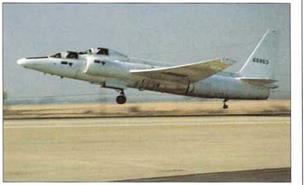Operations
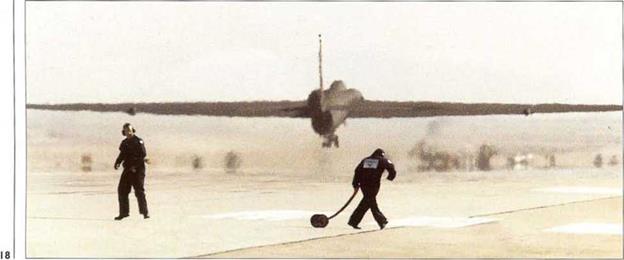
All Agency pilots recruited into Project Aquatone came straight from the Air Force, on a ‘suspended contract’, in which their ‘grey suit’ time counted towards their time served in the military. Two of the initial cadre of six pilots, Marty Knutson and Carmen Vito, were both F-84 ‘jocks’, assigned to the 31st Strategic Fighter Wing, locat-

ed at Turner AFB, Georgia. Having passed various interviews, conducted by mysterious civilians at insalubrious hotels, they next spent a week undergoing one of the most rigorous medicals ever devised, at the Lovelace Clinic, Alburquerque, New Mexico. In all, about 25 pilots, in three intakes, would be recruited into the Agency programme.
Early U-2 training flights w’ere punctuated by a number of flameouts, a situation that continued until Pratt & Whitney engineers perfected high altitude operation of the J57. Such events required the pilot to seek out denser air at 35,000 feet, in order to effect a relight. On a few occasions, when pilots were unable to get a relight, it became necessary to divert. But despite a number of such occurrences, Aquatone remained in the black.
A unique facet of U-2 piloting, was flight in that part of the envelope known as ‘coffin comer’. Having climbed rapidly to 60,000 feet the aircraft would then follow a cruise-climb schedule; as fuel was burned off and the aircraft became lighter, it could climb higher – as high as
Top left NACA/NASA association with the U-2 can be traced back to the beginning of the programme. Initially a CIA paper exercise, designed to cover the aircraft’s true mission, NASA received two U-2Cs (56-6681 and 56-6682 redesignated NASA 708 and 709 respectively), on the 3rd and 4th June 1971, to form its High Altitude Missions Branch (HAMB), based at Moffett Field, California. (Paul Crickmore)
Top right When U-2C 56-6681 was retired in June 1987, its NASA designation, 708, was transferred to an ex-Air Force TR – I (80-1069), which served alongside the purpose-built ER-2 prototype NASA 706 and the remaining U-2C, NASA 709.
(Paul Crickmore)
Above NASA U-2C 709 was retired in April 1989 and at the time of writing, following delivery of the second ER-2, NASA 709, the fleet consists of two ER-2s (now redesignated U-2ERs) and the ex-Air Force TR-1 (U-2R). (Lockheed Martin)
75,0 ![]()

feet in some flight conditions. However, in the rarefied air above 60,000 feet, the never exceed speed curve virtually meets the aircraft stall speed curve. This crucial difference could be as little as lOkts. At high altitude with the engine at full power and in a banked turn, it was possible for the high wing to reach Mach bullet w hilst the inside wing approached stall buffet – exceed Mach buffet by more than four knots and it was possible that the fragile U-2 would disintegrate!
During the Geneva Summit, on 21 July 1955,
President Eisenhower had proposed that an ‘Open Skies’ plan should be considered between the United States, the Soviet Union and other participating countries, wherein a limited number of annual reconnaissance overflights w ould be made in order to verify claims of declared force strengths. Surprised by the proposal, the Soviet delegation reacted favourably and agreed to confer with their Party Secretary, Nikita Khrushchev. He however refused to either sign-up to, or reject the proposal. Such prevarication ensured that ‘Open Skies’ failed one month later, when a vote was taken in the United Nations.
By June 1956, it was judged that initial flight test and
Above left Unique to U-2 operations is the ‘howdah’, which was designed to protect crew members from the sun’s heat.
(Lockheed Martin)
Below U-2R. 80-1082 equipped with short nose but super-pods is seen complete with tail-art at Beale AFB in November 1986.
(Paul Crickmore)
Above Slow sink rate, due to the high aspect ratio wing, has always caused problems when landing U-2s; as a result, every landing – including touch-and-goes, are accompanied by two ‘mobile’ U-2 pilots, one in radio contact, in a fast car. As the U – 2 crosses the threshold it is chased and height-to-go is called-off. (Paul Crickmore)
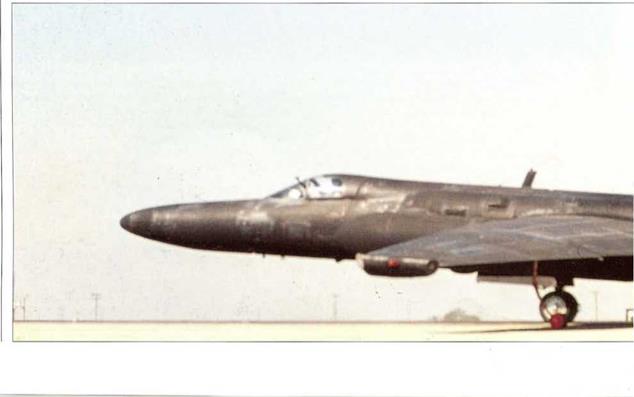
Right Airborne in just over 1,000ft of runway, the U-2’s climb rate has always been impressive; with lighter, earlier models reaching 50,000ft in just 10 minutes. (Paul Crickmore)
![]()
![]()
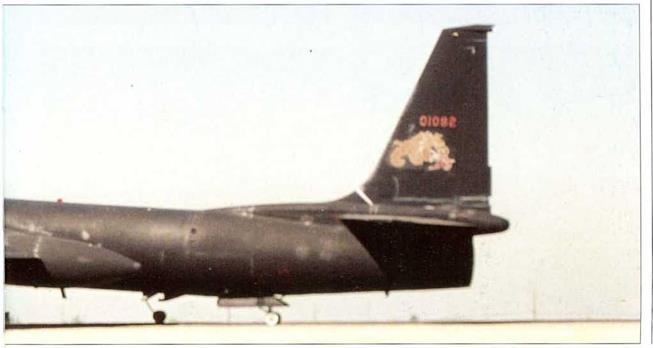
training objectives of the U-2 programme had been completed; accordingly six operational pilots, together with ten U-2s, were deemed ready for operational deployment. The death of Eisenhower’s ‘Open Skies’ proposal led the President to sanction, for an initial ten-day period, a program that would have a profound impact within the intelligence fraternity and on international power politics – Operation Overflight. In anticipation of these events, two U-2s had been air-freighted to RAF
I. akenheath, England on 30 April 1956, where the first of three Agency detachments was formed, under the entirely fictional designation of 1st Weather Reconnaissance Squadron, Provisional (WRSP-1). Known within the
|
|
‘inner circle’ as ‘Detachment A’ and consisting of Agency, Air Force and contracted civilians, no operational sorties were flown from the UK and the unit redeployed to W iesbaden, Germany on 15 June. This new location was situated close to Camp King, the Agency’s main West German intelligence gathering facility, within which intel reports from defectors were collected and then used as a basis for U-2 overflight requests.
The first operational U-2 sortie was flown just four days after Det A’s arrival at W iesbaden. Piloted by Carl Overstreet, the platform overflew Warsaw, Berlin and Potsdam, before recovering back into W iesbaden without incident. Image quality provided by the Type В camera surpassed anything previously seen, and the stage was set for ‘Overflight’ to begin operations against the Soviet Union. This was achieved by Ucrvey Stockman, flying Article 347 on US Independence Day, 4 July 1956.
He flew over East Berlin then across northern Poland via Poznan, onward to Minsk and Leningrad, before exiting via the Baltic states of Estonia, Latvia and Lithuania, landing again without incident back at Wiesbaden after a flight lasting eight hours 45 minutes.
The very next day Article 347 was again airborne, this time with Carmen Vito at the controls on an overflight which included the Soviet capital, Moscow. Again, image quality was exceptional, but on this occasion Soviet fighters tried, unsuccessfully, to intercept the flight.
Yet another mission was successfully completed the following Monday, by which time the Soviet ‘diplomatic cage’ was well and truly rattled. On 10 July the Soviet Ambassador in Washington delivered a formal, public – protest against the flights. Eisenhower was very concerned at the level of provocation that these flights inevitably caused and insisted that henceforth, ten-day blanket clearances were rescinded, and instead replaced by a policy of one clearance, one flight.
![]() The imagery secured by these first sorties was developed and duplicated at Wiesbaden, before one set was despatched by special courier aircraft to Washington (the other set was retained at Wiesbaden in case the first was lost or damaged in transit). Once in Washington, they ended up in a run-down neighbourhood where Art Lundahl, of the Agency’s Photographic Intelligence Division, had set up a secret process and interpretation centre, on the upper floors of an auto repair shop, aptly codenamed ‘Auto Mat’.
The imagery secured by these first sorties was developed and duplicated at Wiesbaden, before one set was despatched by special courier aircraft to Washington (the other set was retained at Wiesbaden in case the first was lost or damaged in transit). Once in Washington, they ended up in a run-down neighbourhood where Art Lundahl, of the Agency’s Photographic Intelligence Division, had set up a secret process and interpretation centre, on the upper floors of an auto repair shop, aptly codenamed ‘Auto Mat’.
The vast amount of quality imagery collected by ‘Overflight’ soon put the Agency at odds with gloomy Air Force predictions about the strength of the Soviet bomber fleet, which forced a downward reappraisal of a National Intelligence Estimate (NIE). One disturbing aspect revealed by the flights however was the ease with which Soviet radar was. able to track them with early warning and height finding radars. This in turn led the Skunk Works to undertake a series of evaluations using various techniques to reduce the U-2’s Radar Cross Section (RCS). Utilising Article 341 up at Area 51, Project Dirty Bird first saw the aircraft’s planform framed by wires of different dipole lengths running from tail to wing.
Another used Radar Absorbent Material (RAM), in the
Top right U-2R, serial ‘1074 of the 99th SRS turns base-leg at Beale during a training sortie – highly expensive mission equipment is removed for such flights. (Paul Crickmore)
Right 1082 taxies to a halt on completion of a low altitude training sortie. Note the externally mounted rear-view mirror, located on the left side of the cockpit canopy. (Paul Crickmore)
Below On 2 August 1988, General Rogers, then Commander-inChief of Strategic Air Command, experienced at first hand a high altitude familiarization flight in a TR-1B. (Paul Crickmore)
![]() form of a metallic grid, known as a Salisbury Screen. Attached to 341’s lower surfaces, this was then covered in ‘Echosorb’ – a microwave-absorbent coating based on black rubber foam; but neither technique proved effective.
form of a metallic grid, known as a Salisbury Screen. Attached to 341’s lower surfaces, this was then covered in ‘Echosorb’ – a microwave-absorbent coating based on black rubber foam; but neither technique proved effective.
It was during a Dirty Bird test flight on 4 April 1957, that Article 341, the U-2 prototype, was lost. Having suffered a flame out at about 72,000 feet. Bob Sieker’s pressure suit inflated, unfortunately the clasp securing the bottom of his face plate failed. With 70 lbs of internal pressure exhausting through the front of the helmet, it would have been almost impossible for Bob to resecure the clasp and within ten seconds he lost consciousness. Article 341 descended in a flat spin, and upon reaching denser air, it appears that Bob revived and attempted a bail out. The aircraft’s wreckage remained more or less in one piece and was eventually found about ninety miles from Area 51. Bob’s body was recovered about fifty feet away, suggesting he may have managed to clear the aircraft just before impact. Kelly Johnson redesigned the face plate clasp and re-evaluated the decision not to equip U-2s with an ejector seat – had this aircraft been so equipped, it is probable that Bob would have survived.
In August 1956, the second cadre of Agency pilots had completed their training up at Area 51 and were shipped to Incirlik AB, Turkey, where they formed ‘Detachment B’, which consisted of seven pilots and five aircraft.
A third U-2 operating location – Det C, was established at Atsugi airfield near Tokyo in 1957 and in February that same year, the last Agency pilots graduated and were dispersed to the three Dets. By now Det A had again moved, this time to Giebelstadt, just south of Wurzburg and shortly afterwards it was merged with Det B. As the 1950s drew to a close, Agency U-2s had successfully completed about thirty overflights of the Soviet Union and considerably more peripheral and training missions.
From its inception, Lockheed, the Agency and DoD otficials all believed that the U-2’s overflight life would last about two years. But as year three drew to a close, there still appeared to be a gap between the U-2’s ability
to overfly denied territory and the Soviet’s to build a weapons system capable of successfully intercepting the intruder. Certainly the program’s accomplishments were approaching legendary status; in addition to revealing the truth about the Soviet bomber fleet, it had, while operating out of Lahore and Peshaw ar, Pakistan, discovered the location of a new 1CBM (Intercontinental Ballistic Missile), test site at Tyuratam, which turned out to be the primary test facility for the new R-7 ICBM (later known by NATO as the SS-6 Sapwood).
The potential threat represented by the Soviet’s SA-2
Below A high accident rate during flight training led to two U – 2As being converted into U-2CT configuration. These were both retired and replaced by three TR-1 Bs. (Paul Crickmore)
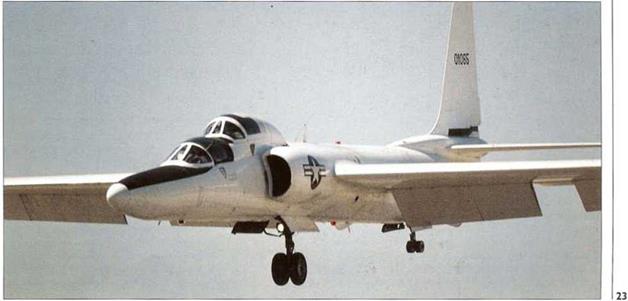
Bottom With the instructor pilot (IP) seated in the raised rear cockpit, a student brings 1065 over the Beale threshold. Ten feet ‘off the deck’ and 200 feet in the overrun, with a I Okt headwind, the throttle is brought to idle and the aircraft ‘driven down’ to just one or two feet, where it is held until it stalls. (Paul Crickmore)
|
|
![]()
 |
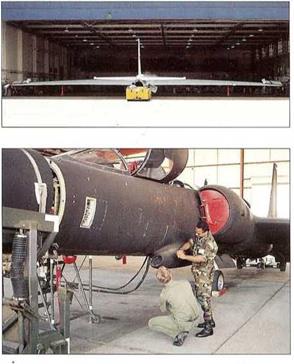 Above Not long after their arrival at Beale, the white training birds were painted black. Later their designation was changed fromTR-IBs to U-2RTs. When re-engined with the FI 18,they became U-2 STs; and finally today they are designated TU-2Ss.
Above Not long after their arrival at Beale, the white training birds were painted black. Later their designation was changed fromTR-IBs to U-2RTs. When re-engined with the FI 18,they became U-2 STs; and finally today they are designated TU-2Ss.
(Paul Crickmore)
Right Designed to fit on an aircraft carrier’s elevator, the outer 6 feet of a U-2R’s wing folds inboard. (Paul Crickmore)
Guideline, surface to air missile (SAM) system, touting a kill pattern of about 400 feet, was certainly appreciated by U-2 mission planners, who gave known sites a berth of up to 30 miles. Further precautions saw the introduction of a rudimentary Electronic Countermeasure (ECM) suite. Designated System 9, this simple range gate pull-off (RGPO) device, was located in a small aft-facing compartment at the root of the vertical fin. Switched on by the pilot upon entering denied territory, it had the capability of breaking lock if illuminated by an airborne intercept radar. Additional comfort came from the first major U-2 upgrade which had just been initiated; five aircraft were reworked into U-2C models, powered by an uprated Pratt & Whitney J75 engine, which enabled the aircraft to climb an additional 5,000 feet.
On the diplomatic stage a visit by Khrushchev to the United States prompted a reciprocal invitation for Eisenhower to visit the Soviet Union during 1960.
In the meantime, it was agreed a summit would be held in Paris, to which both the British and French would be invited. A thaw in the frosty relationship between the two super powers seemed in prospect. However, all this was about to change.











